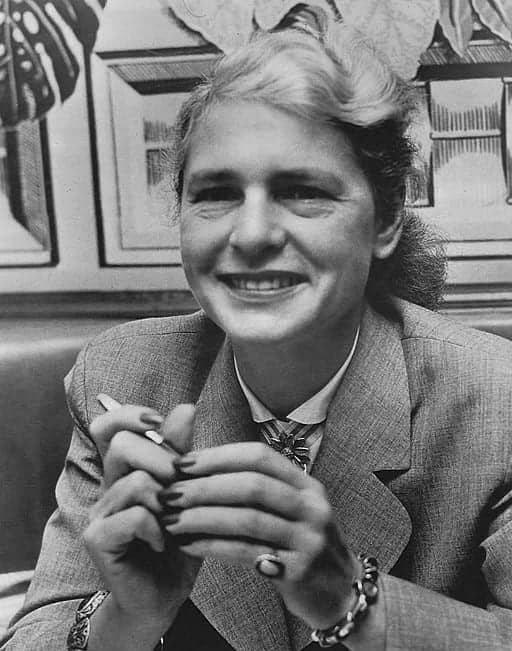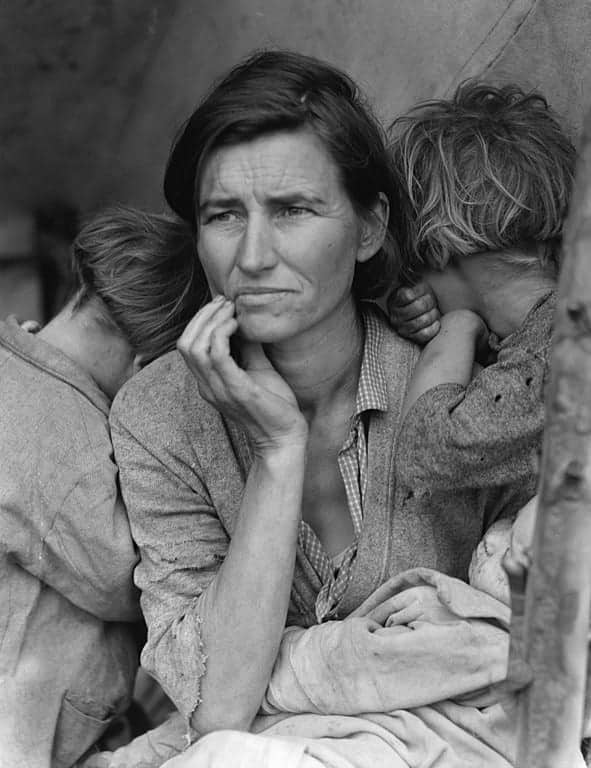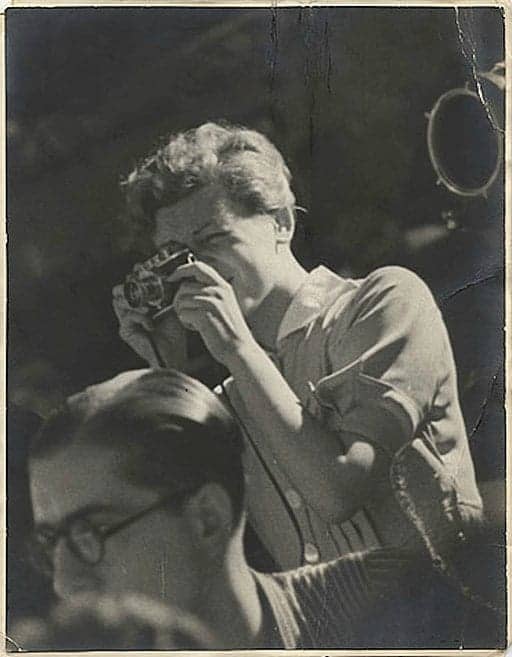- Total103
- Facebook76
- Pinterest22
- Email5
Female Photographers Who Made a Difference
Photography wouldn’t be where it is today without the work of some of the greatest female photographers.
In honor of Women’s History Month, we’re giving the spotlight to the women who’ve helped change the face of photography as we know it.
Annie Leibovitz (Oct. 2, 1949 - )
“A thing that you see in my pictures is that I was not afraid to fall in love with these people.”
Annie Leibovitz Tweet

Annie Leibovitz is a portrait photographer most famous for her works for various notable publications chiefly Rolling Stone and Vanity Fair. Her brilliance at capturing the true essence and vibrance of her subjects’ personalities and providing audiences with a glimpse into their personal lives is what makes each of her photographs so captivating.
In 1970, Leibovitz became the first woman to be named chief photographer of Rolling Stone magazine where she developed their distinctive look and aesthetic of using bold primary colors and unconventional poses. In 1983, she moved to Vanity Fair where she honed her personal style of staged and brightly lit portraits, and still often contributes to the magazine to this day.
Today, Leibovitz has become synonymous with celebrity portraits. She famously took the last image of a nude John Lennon curled around his fully clothed wife, Yoko Ono, hours before his death in 1980. Her other exemplary work involves a very pregnant and vulnerable Demi Moore, Sylvester Stallone mimicking Rodin’s The Thinker, and Queen Elizabeth II surrounded by her younger grandchildren and great-grandchildren.
Margaret Bourke-White (June 14, 1904 – August 27, 1971)
“Photography is a very subtle thing. You must let the camera take you by the hand, as it were, and lead you into your subject.”
Margaret Bourke-White Tweet

Margaret Bourke-White was an American photographer famous for her photojournalism, especially for her work for LIFE magazine.
Bourke-White immersed herself in some, if not the most momentous events of the twentieth century, making her arguably the most famous and respected news photographer of her generation. She documented the effects of the Great Depression, and was the only Western photographer present during the German invasion of Russia. As a member of the General Patton cavalcade, she was there to document the liberation of the Nazi death camps, witnessed Gandhi’s fight for India’s independence, risked her life during the dawning of apartheid in South Africa, and experienced the Korean War firsthand.
She has collected several other “firsts” under her belt including being the first industrial photographer, LIFE’s first female photographer, has earned the distinction of being the first accredited female American WWII photographer, and was the first woman to take her camera into the combat zone.
Bourke-White served as an inspiration for many other female photographers to come such as Lynsey Addario, Diane Arbus, Mary Ellen Mark, and Susan Meiselas.
Diane Arbus (March 14, 1923 – July 26, 1971)
“I always thought of photography as a naughty thing to do — that was one of my favorite things about it, and when I first did it, I felt very perverse.”
Diane Arbus Tweet
American photographer Diane Arbus is famous for her intimate black-and-white portraits of individuals in the margins of society. She was drawn to street people, the mentally ill, transgenders, nudists and carnival performers. Her work has a polarizing effect on people, drawing equal parts compassion and repulsion from its audience. Arbus was known for breaking social conventions when it came to established distances between the photographer and subject, giving rise to her raw and personal portraits.
Arbus was skilled at making her subjects feel at ease, and they would be as enthralled with her as she was with them. It was by letting their guard down that she was able to capture her subjects at their most vulnerable state, showing them as clearly as possible, both through her choice of hyper-clear photos and her adeptness at capturing her subjects’ true character.
Dorothea Lange (May 26, 1895 – October 11, 1965)
“The camera is an instrument that teaches people how to see without a camera.”
Dorothea Lange Tweet

Dorothea Lange was always passionate about photography. Her heart, however, lay in documenting the plights of those suffering during the Great Depression. One of her famous works, a photo of pea-picker Florence Owens Thomspon, became the icon of the Great Depression and is one of the most recognizable photos in history.
Although she had her own studio, she had little interest in classifying her photos as art. She took photos to effect social change. She felt most free outside the studio, capturing a nearby breadline, or the oppressed.
Her commitment to giving a voice to social justice through her images remained steadfast her entire life.
She was assigned to document the wartime internment of Japanese Americans, which she was strongly against, in 1942, but her critical images were subsequently censored by the US government throughout the duration of WWII. In 1945, she was tasked once again by the Office of War Information to document the San Francisco conference that gave rise to the United Nations.
Until her last days, Lange believed that her work did not always move society to correct the injustices she documented. While this may or may not be the case, Lange did inspire generations of documentary photographers who continued her mission long after her passing.
Gerda Taro (August 1, 1910 – July 26, 1937)
“If your pictures aren't good enough, you aren't close enough.”
Robert Capa (Pseudonym shared by Gerda Taro & Endre Friedmann) Tweet

Gerda Taro was one of history's first and greatest war photographers. Unfortunately, her dedication to her craft also cost her her life, and she died on the frontline of war.
Known as “the little red fox” for her ginger hair and petite frame, Taro, then an émigré from Germany named Gerta Pohorylle, met fellow refugee Endre Friedmann in Paris. They quickly developed a bond that soon blossomed into a relationship. It was from him that she learned the basics of photography.
Their clearly Jewish last names made it difficult to find work once Hitler became chancellor, and so they decided to adopt new personas. Friedmann invented the American Robert Capa identity while Pohorylle went with Gerta Taro.
Initially working as a pair, Taro gradually earned the confidence, and courage, to work on her own, evidenced by her taking more and more dangerous assignments. She was drawn to covering women in the militia and was motivated to raise awareness of the hardships of Spanish civilians and soldiers fighting for freedom.
Sadly, she died on the battlefield, as she was crushed by a tank while she was documenting the Battle in Brunete. Her photos from that day were never recovered.
Because they often shared the pseudonym Robert Capa, many of her photographs were mistakenly credited to him, and she was all but forgotten. That is, until 4,500 negatives of her and Capa’s work were recently discovered in Mexico City, bringing to light the critical work Taro has contributed in her short time on Earth.
Laylah Amatullah Barrayn
“It became an important way of knowing who I was, through my family and through images that my mother created. [Her photos were] powerful and they affected me—who I am, who I know myself to be.”
Laylah Amatullah Barrayn Tweet
Laylah Amatullah Barrayn is an independent documentary photographer from Brooklyn, New York. Inspired by her mother’s fondness for documenting family gatherings, Barryn came to associate photography and her mother’s photos as an integral part of who she was.
Barryn has spent the last two decades travelling to Senegal to pay tribute and homage to its Sufi culture. Raised in a Sufi household herself, the Senegalese culture deeply resonates with her, and is clearly visible in each of her vibrant photos. Her photos show a particular reverence towards the people, something you don’t get from many visiting photographers.
Barryn’s body of work, which also features subjects such as resistance movements in West African Sufism and queer identities among Black women in New York City, have been exhbitied in various galleries including Galarie Ethiopiques (Senegal), Brighton Photo Biennial (UK), Galleria Biagiotti (Italy), Open Ateliers Zuidoost Gallery (Holland), Rencontres d'Arles (France) and The Museum of Contemporary Photography (USA), among other institutions.
She has also contributed to several renowned publications namely The New York Times, OkayAfrica, The Washington Post, Le Point Afrique, CBS News, and Vogue.
Mary Ellen Mark (March 20, 1940 – May 25, 2015)
"What I'm trying to do is make photographs that are universally understood... that cross cultural lines. I want my photographs to be about the basic emotions and feelings that we all experience."
Mary Ellen Mark Tweet

Mary Ellen Mark was an American photographer most known for her documentary images, especially of the marginalized.
Arguably, Mark’s best work was done when she relocated to New York City (which also heavily influenced her work), where she would spend most of her life. She was known for shedding a light on key social issues through her photographs including homelessness, loneliness, drug addiction, and prostitition. She favored black-and-white photography, which added even more impact to these heavy topics.
Mark was dedicated to her craft, immersing herself in the life of her subjects. For one of her best-known works, she lived for two months in a high-security women’s ward at the Oregon State Hospital to capture the turmoil of mentally ill women confined in a locked ward. The resulting images, published in Ward 81 (1979) were Mark’s attempts to capture the human condition with both compassion and objectivity.
Other notable work include her numerous trips to India to document the prostitutes of Bombay (now present day Mumbai), and the service of Mother Teresa and her congregation. These trips resulted in three books: Falkland Road: Prostitutes of Bombay (1981; in colour), Photographs of Mother Teresa’s Missions of Charity in Calcutta, India (1985), and Indian Circus (1993).
In addition to her photojournalistic work, she is also a noted portrait and advertising photographer. She has regularly contributed to several magazines such as LIFE, The New Yorker, The New York Times Magazine, Rolling Stone, and Vanity Fair.
A Lasting Legacy
These women are not just amazing female photographers.
Each of the women profiled are simply remarkable photographers in their own right.
From significant contributions toward social justice and acceptance for marginalized groups, to all-round artistic excellence, their work is staggering.
I hope you're as inspired as I am by their achievements and legacies.
- Total103
- Facebook76
- Pinterest22
- Email5





14 thoughts on “7 Iconic Women Photographers”
You may be surprised to learn about the work of Austrian American Photographer Trude Fleischmann. Hedy Lamar, Albert Einstein and Eleanor Roosevelt as well as 1920’s-1930 gorgeous sculptural nudes are among her thousands of portraits. She is a ground -breaking female photographer who inspired Marian Post Wolcott among others.
Thanks for the added information!
Thanks David for casting light on these phenomenal talents!
They truly deserve a spotlight, don’t they?
Wow! Very inspirational and motivating. Thank you for highlighting these courageous and intriguing women.
Deborah, they earned and deserve the highlighting. Truly iconic!
I just love reading about what motivated them to take pictures. I love photography but I’m also afraid of it. Maybe one day I’ll get over that fear
Wilma, please don’t be afraid. You can venture out by taking some photographs of things that interest you and grow from there. You got this!
❤️ Thank you! Never too old to keep dreaming & sure working towards creating my own photography legacy!
NEVER EVER too old! Always dream!
I thought you’d have Vivian Maier http://www.vivianmaier.com on the list for sure!
Maybe we will have to do another blog about more women. There are many more out there.
Loved the article….will be looking them all up. I wish Sue Bryce would have been included. Thank you.
I just mentioned to Mary Jane that I might have to do another blog. There are many incredible women photographers and I only had so much blog room. Thank you for mentioning Sue Bryce.